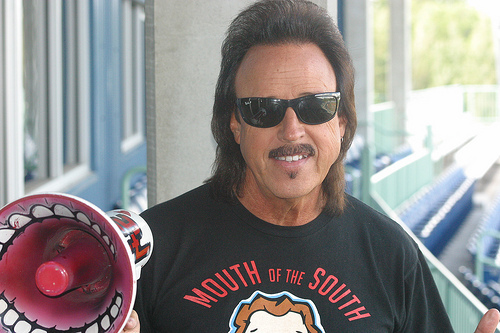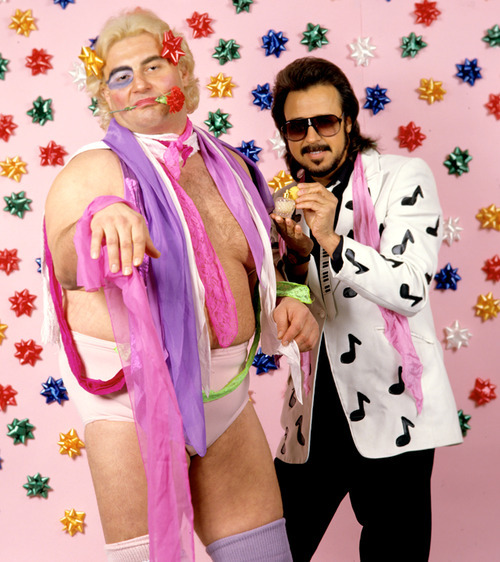"Back in the old days...I think you could get away with whatever you wanted to do," said World Wrestling Entertainment legend Jimmy Hart of the professional wrestling industry, "Now, you have to watch what you say, watch what you do."
Not that "The Mouth of the South" is complaining, of course. While promoting WrestleMania 31 -- pro wrestling's SuperBowl coming March 29, 2015, to the spanking new Levi's Stadium in Santa Clara, CA -- Hart spoke enthusiastically about changes in sports entertainment during his iconic career as a pro wrestling manager, specifically advancing awareness of the LGBT community.
In recent years, fellow legend and former World Wrestling Federation (pre-corporate name change) Intercontinental champion Pat Patterson has opened about his sexuality. In August 2013, 31-year-old Darren Young became the first active wrestler to come out while still signed to a WWE contract. Both reflect society's changing attitude toward the LGBT community, but Hart suggested this is not new within the industry.
"We've been around the locker room and people coming out," he said during a recent telephone interview. "What's so funny, outside, everybody makes such a big to-do of it, but inside, we're just brothers and sisters, having a great time, and everybody just overlooks those things and goes about their business."
Still, this newfound sensitivity toward diversity is a far cry from industry practices early in Hart's decades-long career. In the '80s, during its boom days, the then-WWF frequently keyed into society's hot-button topics. Seen as an easy road to creating "heat" (in layman's terms: animosity) or affection for its competitors, pro wrestling was rife with one-dimensional caricatures.
Notorious for racial and minority stereotyping, villainous Cold War-era Russians, Jive-talking pimps, evil Iranians, savage Africans, "man-eating" Samoans and more ran roughshod through WWF. All of these characters reflecting "society's ills," of course, ultimately fell at the hands of "The Real American" Hulk Hogan. During this time, Hart was instrumental in the rise of perhaps pro wrestling's most infamous character reflecting to the LGBT community. 
In late 1985, under Hart's tutelage, New York-born Adrian Adonis began an abrupt on-air transformation. After giving away his signature leather jacket (itself a gay stereotype, which the WWF might not have recognized), Adonis began to host a talk show segment called "The Flower Shop" and project an increasingly feminine character, both through mannerisms and attire.
"We didn't try to make him any particular character, one way or another," Hart said of Adonis. The manager, best known for carrying a mega-phone to the ring, insists the intent was never specifically to imply the former WWF World Tag Team champion was gay. He said instead: "We just wanted to make sure he was flamboyant."
According to Hart, he and the now-deceased Adonis -- who was heterosexual -- drew inspiration from the legendary "Gorgeous" George. The 1950s-era grappler innovated a style of showmanship standard for many of today's wrestlers. Accompanied to the ring by a female valet, he wore flashy clothes and primped in-ring before matches.
"What a draw, what a great person he was!" Hart said of the trend-setter, "Just by the way he curled his hair, had bobby pins and walked to the ring with a little swagger and threw them out there, people responded to him so unbelievably and packed the place."
But if "Gorgeous" George was the mark for which Adonis and Hart were aiming, the duo overshot it by miles! With newly-bleached hair and insistence the ring be sprayed with perfume (both trademarks of his predecessor), "The Adorable One" sported absurd make-up and pink ring attire including scarves, legwarmers and, on occasional, dresses. By WrestleMania II in 1986, the once tough-as-nails Adonis' transition (so to speak) to full-blown cross-dresser was complete.
"He was still Adrian Adonis -- phenomenal in the ring," recalled Hart. Yet to viewers, Adonis reflected other outrageous (largely openly gay) celebrities of the time such as Boy George.
Adonis' effeminate demeanor and dress roused audience ire and bigotry -- and was a frequent talking-point, often laced with homophobic overtones, among his macho opponents and announcers alike. (See the video above, which makes multiple "coming out of the closet" references.) Hart says this would not fly in today's WWE.
"Now if they did a character like that, I don't think it would be so flamboyant," Hart opined. "Times have changed, and people see things different nowadays.
"The program [Monday Night Raw; Friday Night SmackDown!], Vince [McMahon, owner and CEO] and the WWE have been sensitive over certain matters," noted the superstar, acknowledging the WWE's current Be a Star Campaign to stop bullying.
"You can still draw tons and tons of money that way," he concluded, "People can still have fun and not hurt others."
